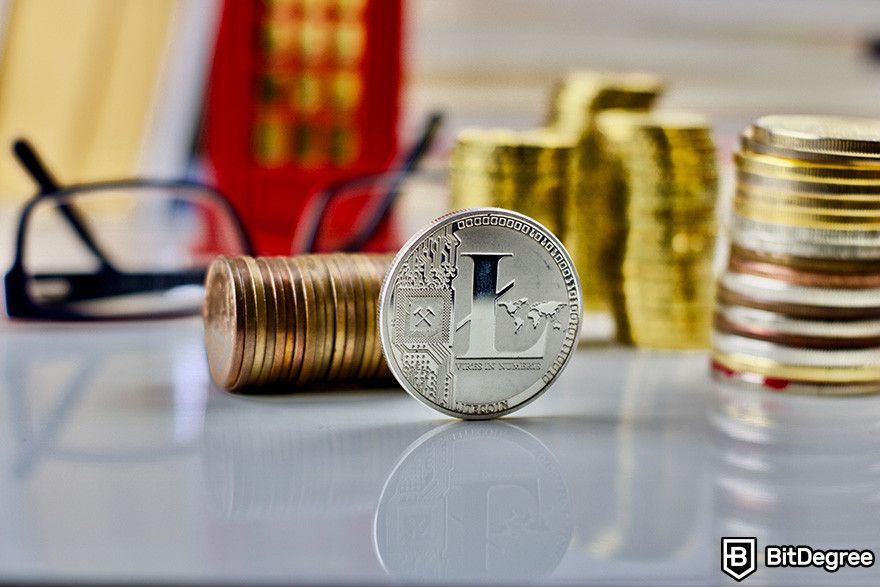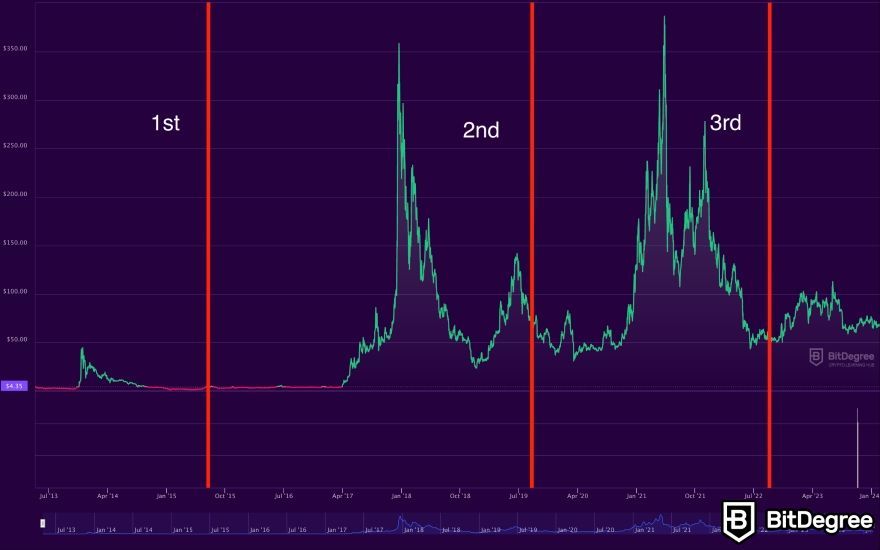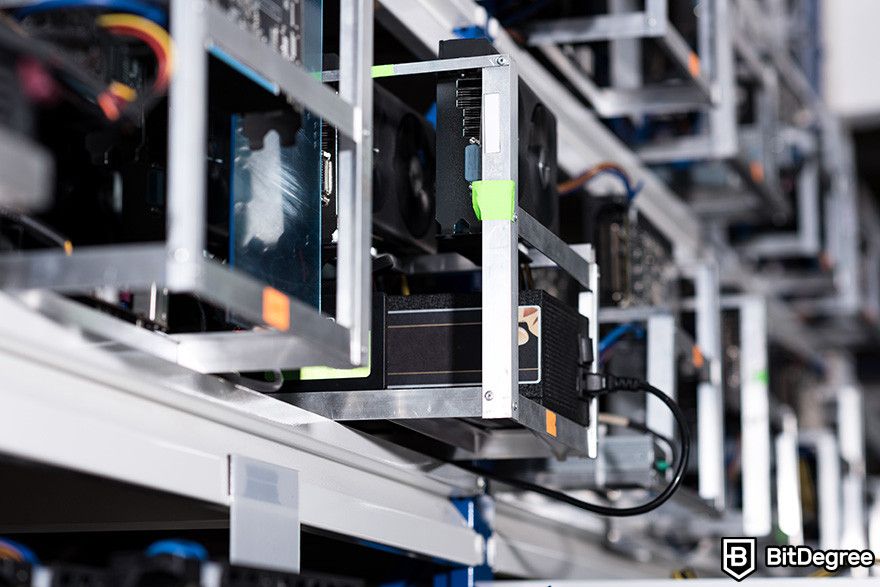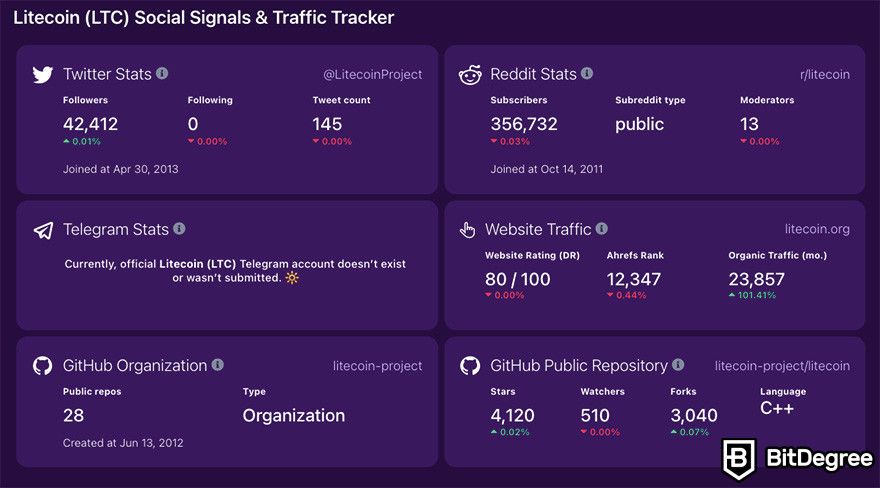Litecoin Halving Countdown
Time remaining until Litecoin block rewards will be cut in half:
🎁 Free Airdrop Season 7 is LIVE! Answer fun questions or do simple tasks to earn rewards from the $30K BitDegree prize pool. Participate Now !
Litecoin
LTC| Halving | Est. Halving Date | Block | Block Reward |
|---|---|---|---|
| #1 | August 25, 2015 | 840,000 | 25 LTC |
| #2 | August 5, 2019 | 1,680,000 | 12.5 LTC |
| #3 | Sometime in 2023 | 2,520,000 | 6.25 LTC |
Market Cap
$6,119,926,093
Circulating Supply
75,558,468 LTC
Max Supply
84,000,000 LTC
Hash Rate
2.5Ph/s
Mining Difficulty
84.5M
Current Block
2,879,122
Current Block Reward
12.5 LTC
Block Reward After Halving
6.25 LTC
Litecoin is one of the most popular cryptocurrencies on the market, as well as among the oldest assets in the space. Same as its “big brother,” Bitcoin, Litecoin comes equipped with a mechanism called “halving”. If you’re curious about Litecoin halving dates, how this process works, and how it affects the general crypto industry, you’ve come to the right place!
When is the Next Litecoin Halving?
The next Litecoin halving date is expected to be September 11th, 2027. This date can differ, however, depending on a few different factors. To see the exact point in time when the next LTC halving will occur, take a look at the countdown above.
When Will the Last Litecoin Halving Happen?
At this point in time, it’s not yet clear when the last Litecoin halving will occur. However, judging by the numbers, it’s going to happen many years in the future - the current estimation is the year 2142.
What is the Litecoin Halving History?
Litecoin has had three halving events already - one in 2015, one in 2019, and another in 2023. In turn, while the block mining rewards were 50 LTC in 2011 when Litecoin was created, they are currently 6.25 LTC per block, and after the 2027 LTC halving, they’ll be 3.125 LTC.
What is Litecoin Halving?
Now, let’s get the definitions out of the way first.
Litecoin halving is an event when the LTC mining rewards get cut in half. Simple, right?
On a more serious note - while it may sound pretty simple at first, there’s actually a lot of background and weight that follows that definition. And, in order to fully understand the significance of LTC halving dates, we need to take a step back and look at the technology side of Litecoin first.
Litecoin’s History & Proof-of-Work
As I’ve mentioned earlier, Litecoin was created in 2011. The purpose of this crypto project is actually very straightforward - to improve on the technology of Bitcoin in every way possible.
The (arguably) biggest improvement, and the one that’s most relevant to our Litecoin halving discussion, is the transaction speed. Specifically, Litecoin offers transaction speeds up to 4 times faster than those of the Bitcoin blockchain.
This also means that while a BTC block takes 10 minutes to mine, Litecoin blocks get mined around every 2.5 minutes. This metric is significant when calculating the specific LTC halving date.
All of that might make little-to-no sense if you’re not familiar with cryptocurrency mining, Proof-of-Work, and the fact that, from a general perspective, Litecoin’s blockchain is very similar to that of Bitcoin. Now, while I won’t get into the details of the processes that I’ve just mentioned, let’s still have a quick rundown so that we’re both on the same page.

Cryptocurrency mining is a process where miners (people like you and me, or even large companies) employ their devices (either personal computers or special mining machines) to confirm transactions that are happening on a crypto network. By approving these transactions, miners “mine blocks” (since transactions are stored in these data blocks) and add them to the blockchain.
If you’re the one who successfully mines the block, you receive a reward for your work. This reward is exactly what gets halved every time a Litecoin halving takes place.
The process of mining crypto is part of “Proof-of-Work”, a broader methodology of how certain networks (blockchains) confirm transactions and keep themselves secure. Both Bitcoin and Litecoin use Proof-of-Work and thus act very similarly halving-wise.
How Does Litecoin Halving Work?
Now that you’re familiar with the core general concepts surrounding Litecoin halving, we can get a bit more specific and explore the phenomenon in question.
LTC halving dates back to 2015, when the first halving of this crypto asset occurred. Since its creation, halvings have been occurring on the Litecoin network every 4 years or so - check the table below for more details:
| Date | Block Height | Block Reward |
|---|---|---|
| October 7, 2011 | 0 | 50 LTC |
| August 25, 2015 | 840,000 | 25 LTC |
| August 5, 2019 | 1,680,000 | 12.5 LTC |
| August 2nd, 2023 | 2,520,000 | 6.25 LTC |
| Est. September 2027 | 3,360,000 | 3.125 LTC |
| ... | ... | ... |
| Est. 2142 | ? | ? |
Table: Litecoin halving schedule
Now, then… What does this table tell us?
Well, first of all, with some basic maths, you can see that Litecoin halving dates depend on when 840,000 blocks have been mined. With an average block time of 2.5 minutes, this equates to roughly 4 years - we’ve established that much already.
At the very beginning, when LTC was first introduced, the block rewards were 50 LTC each. The exact same was true with Bitcoin as well - in this regard, Litecoin follows Bitcoin’s pattern very closely. Bitcoin also started with a 50 BTC block reward and experiences a halving event every 4 years, too.
Going back to LTC, the very last halving of this particular cryptocurrency is expected to happen around the year 2142. The Litecoin rewards for mining a block will, naturally, be quite negligible by then, and it is estimated that around this time, LTC will reach its maximum block height.
Granted that it’s more than a hundred years away, it's safe to say that we don't really need to worry about it right now.
With all of this discussion about the specifics of LTC halvings, we’ve yet to address one of the biggest elephants in the room - *WHY* does Litecoin halving exist as a concept in the first place?
Well, the cynical answer would be - because Bitcoin halvings exist, and with Litecoin being so similar to BTC, it simply adopted the process, too.
An answer like that is obviously useless. The truth of the matter is that halvings serve one big purpose - an effort to synthetically (artificially) increase the price of the underlying asset in the long term.
How do Litecoin Halvings Affect the Price of LTC?
We’ve already established that whenever a Litecoin halving happens, the block mining rewards get cut in half. That being said, this can also be seen in a bit of a different way - the supply of new Litecoins entering the market is halved as well.
Now, theoretically, if there’s enough demand for a particular asset (in this case - LTC coins), and the supply gets cut in half, it should drive up the price for that asset since it has now become more scarce.
I use vague terminology simply because this isn’t necessarily always the case. This is especially true with cryptocurrencies - since the industry is still very young and, thus, extremely volatile, there’s not enough market logic to go around, and sometimes asset prices may rise and fall without an apparent reason.
In turn, it could also mean that during a crypto halving event, there won’t be a price hike - or, at least, not one that many investors would expect.
What’s the situation with Litecoin halvings, specifically? Well, take a look at the graph below:

As you can see, the situation regarding the LTC halvings is quite… Interesting.
After the first halving, LTC saw a bit of a price bump, albeit not immediately. While 1 LTC coin would cost around $2.99 around the time of the halving, afterwards, the price would sway around the $3.50 - $4.00 mark.
Then, in 2018, Litecoin skyrocketed in price - this has nothing to do with the LTC halving dates, but rather, was due to the overall situation within the market. After crashing down significantly, the asset would then start climbing back up at the beginning of 2019, only to start falling back down right around the time of the second Litecoin halving.
If you’d like to check out the charts for yourself, take a look at our crypto tracker tool - you’ll be able to perform an analysis of your own!
However, it’s rather evident that the halving events didn’t impact Litecoin’s price all that much. While the first halving might have contributed to the bump in price that LTC experienced right after, the second Litecoin halving coincided with a decline in the asset’s price and didn’t manage to stop it. The third halving didn't necessarily have much of an impact, either, although the price of LTC did start fluctuating around the same area somewhat steadily right after.
So, then… What’s the conclusion here? Do Litecoin halvings simply not work as they’re intended to?
Well, no - the matter is quite a bit more complicated than that.
While no one can say for sure why Litecoin halvings work or don’t work throughout a specified amount of time, it’s clear that the crypto market - Litecoin included - reacts to a huge variety of things. Positive and negative news, major events, and everything in between can influence the price of an asset.
Following that logic, Litecoin halvings might simply not be “major” enough to cause any noticeable changes in the price of the crypto. Or, perhaps some major news events that coincide with the halvings overshadow them? The reasons can be plenty, and it’s thus important to do a lot of research to figure out what happened during specific Litecoin halving dates!
What are the Litecoin Halving Price Predictions for 2027?
As more and more people learn about the Litecoin halving dates, and as those dates start approaching closer and closer, there’s an uptick in LTC price predictions on the internet, as well.
What will happen after the next Litecoin halving? Will LTC rise in price? Or will it crash even lower? These are some of the most common questions that crypto enthusiasts ask - however, is there really a single, accurate answer to them?
No, of course not. Any and all price predictions are nothing more than entertainment, or educated guesswork, at best. Thus, you should never take such predictions seriously or without a massive grain of salt.
Let’s entertain the idea, however, and try to establish a logical chain of events that could lead to LTC either rising or falling in price after the next halving.
Admittedly, no matter the preferred outcome, it will all boil down to the general market sentiments around the time of the halving. So, if the market is bullish, and most of the main, best-known assets are rising in price, the Litecoin halving might give an additional boost to LTC.

On the other hand, if we find ourselves in a bearish market when everyone’s busy selling their coins and tokens, this would likely result in minimal-to-no price influence as far as the halving goes.
While this likely isn’t the price prediction that most people are looking for, it’s the honest truth. What’s worth adding, though, is that market sentiments don’t just manifest out of thin air.
They are a combination of some global events combined with the news coming out of the cryptocurrency market itself. Each individual project can influence these sentiments quite significantly - Litecoin isn’t an exception!
If the general opinion surrounding Litecoin is positive, around the time when the next LTC halving date comes around, and there’s a lot of good news surrounding the project, the halving could have some very positive effects on the price of the asset. The opposite is also true - we’ve covered that much already.
One last point that I want to mention is that Bitcoin is probably the only cryptocurrency that has some very notable halvings, accompanied by significant price swings. This is simply due to it being, well… BITCOIN and having such a massive influence on the rest of the market.
The Significance of Litecoin Halvings
Now, we’ve gone through the Litecoin halving dates, price predictions, as well as the general details surrounding the phenomenon in question. What we’re yet to address, though, is the true significance of LTC halving dates to specific groups of people.
With Litecoin being a top-tier crypto asset that utilizes Proof-of-Work technology, there are really three groups worth mentioning - miners, investors, and the general crypto community as a whole.
Miners
Without a doubt, Litecoin miners are the group that will be impacted the most. It doesn’t even really matter if the LTC halving causes the price of the coin to go up or down - it’s going to be a controversial topic either way.
Why are LTC halvings controversial to miners, though?
Well, for starters, as you might have figured out by now, miners are directly impacted by the phenomenon - it is their mining rewards that get cut in half each time a halving event occurs.
Naturally, this would immediately invoke negative reactions. However, the kicker here is that the halving is done in order to make the LTC price go up, both immediately and in the longer term. Thus, if you’re a miner, while your rewards would be lower, they would be worth more at the end of the day.
Theoretically speaking, that is.

However, this proportion doesn’t always work out, and some miners - especially those who first started mining crypto right before a halving event - can be left with significant losses. This isn't good because:
Miners lose money → They leave the network in search of other mining opportunities → the network becomes less secure → chances of a 51% attack increase, causing the price of the asset to plummet even more.
On the other hand, most miners who decide to get into LTC mining - or mining of any other halving-employing cryptocurrency, for that matter - know and understand that the halving processes are necessary to keep the project attractive and the price of the underlying asset stable.
As you can see, it really is a difficult issue to navigate. Thus, if you were to ask five miners how they feel about Litecoin halving, you’d probably hear five different answers!
That being said, same as with any other group of individuals, the sentiments that miners possess will depend heavily on the position that Liteocin finds itself in, market-wise, at that specific point in time.
Investors
As far as opinions regarding Litecoin halvings go, investors are on the completely opposite end of the scale from the miners. It’s pretty simple, really - if you’re an investor in LTC and are looking to maximize your profits by buying, selling, or trading the coin, you’re probably going to love everything that could increase the price of said asset.
With LTC halving dates being set in place specifically for this purpose, the conclusion is quite self-explanatory.
In the world of crypto, however, there’s a concept called “buy the rumor, sell the news”. This essentially means that investors might buy up as much Litecoin (or any other crypto) as they can before the halving occurs, and then sell it right before or on the day of the event.
Why would they do that? Well, halvings tend to generate a lot of buzz around them - be it within the community itself or, if it’s significant enough, from media outlets, too.
This, in turn, puts more eyes on the asset, and more people might decide to purchase it. The price of the coin would then increase, which is once again great for investors.
Naturally, though, this is just one of the factors surrounding any and all price changes during the actual Litecoin halvings. On top of that, it’s only theory, as well - often, in the real world, things might not necessarily pan out as simply.
The General Crypto Community
The last group of people that might get impacted by the Litecoin halving phenomenon is the general global crypto community - enthusiasts who might not hold LTC themselves but be interested in the technology of the coin or the crypto space as a whole.
Admittedly, looking at the historic Litecoin halving dates, it seems that this phenomenon doesn’t really cause a significant impact on this group of people at all. While Litecoin is definitely a major project, its halving events simply aren’t significant enough to move the market in either direction or to cause some sort of a major reaction.
That’s not necessarily a bad thing, either!

If you’re interested in the technical details of crypto halvings, sure - Litecoin could serve as a prime case study. On top of that, if you want to mine crypto but are still in the planning stage of things, LTC halvings become super-important to consider, as well.
If none of that applies to you, though, then it’s likely that you won’t even notice these halvings happening from a general market fluctuation perspective.
Summary
By this point in the text, you should have a pretty good idea of everything related to Litecoin halvings - the dates, how it works, what happens, what SHOULD happen, why it matters, and so on.
That’s a lot of information to take in at once! Below are some key takeaways from everything that we’ve talked about:
- Litecoin halving is a process when mining rewards get cut in half;
- Its purpose is to cause artificial price inflation of the LTC coin;
- Litecoin halvings happen every 4 years (approx.), or every 840,000 blocks;
- There have been three LTC halvings, with the fourth one happening in 2027;
- In the past, halving events don’t really seem to have had a significant influence on the price of Litecoin.
If you keep all of these things in mind, you’ll essentially know all of the important information surrounding Litecoin halvings. However, note that since the phenomenon is quite unique and present only on specific blockchain networks, it’s definitely worth diving deeper into!
This is, once again, especially true if you plan to mine LTC or invest in the network in any way. Understanding how halvings work will keep you one step ahead of your competition and help you comprehend how Litecoin functions in general!
Conclusions
Thanks for reading my Litecoin halving overview! Make sure to keep an eye on the countdown above - you’ll be able to see just how much time is left until the next halving event and plan your strategies accordingly!
Additionally, you may also want to check out our Bitcoin halving countdown as well. With Litecoin and Bitcoin being so similar, it’s interesting to compare the halving processes of both of these assets! On top of that, BTC halvings tend to be major events within the industry - it’s a good idea to track them either way!
Other Halving Dates

